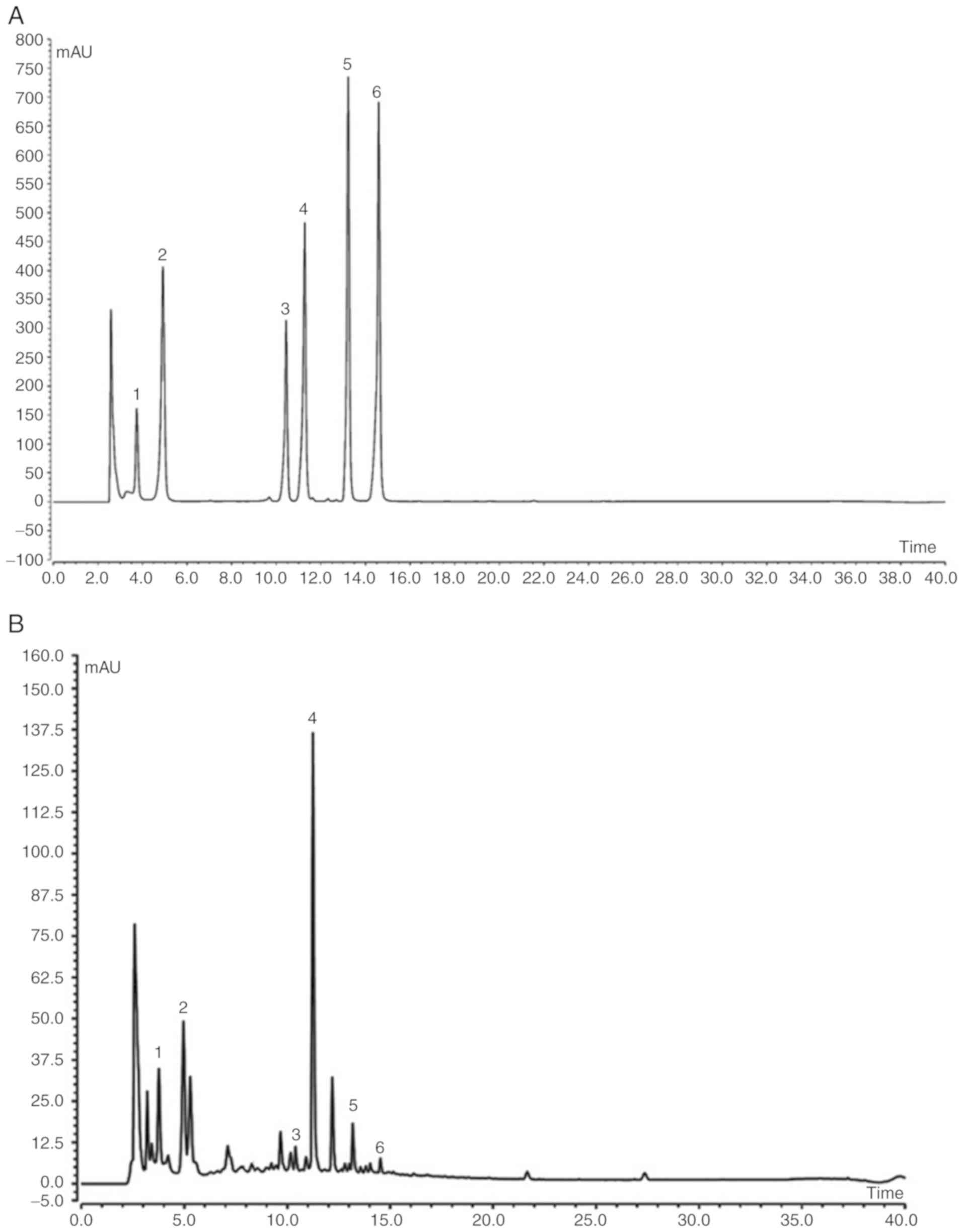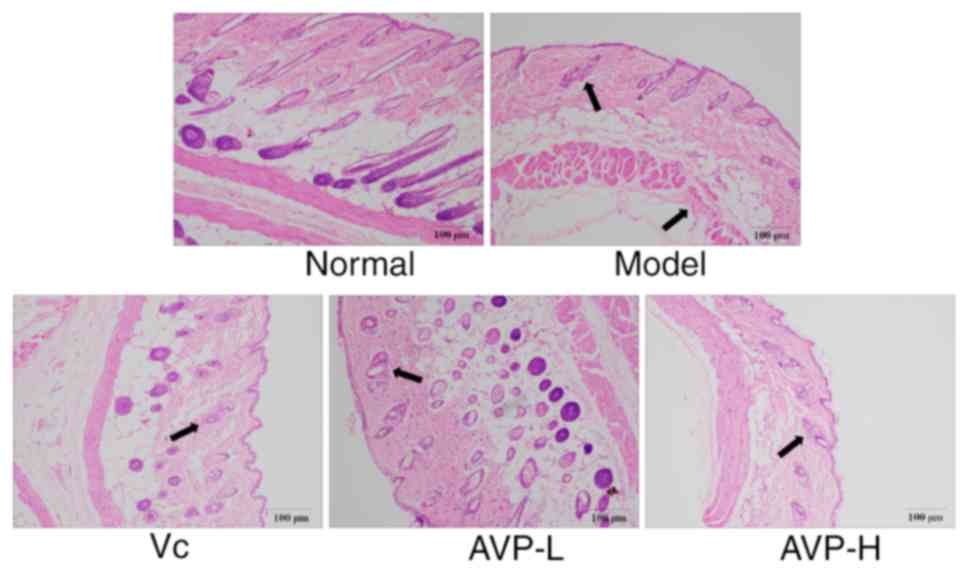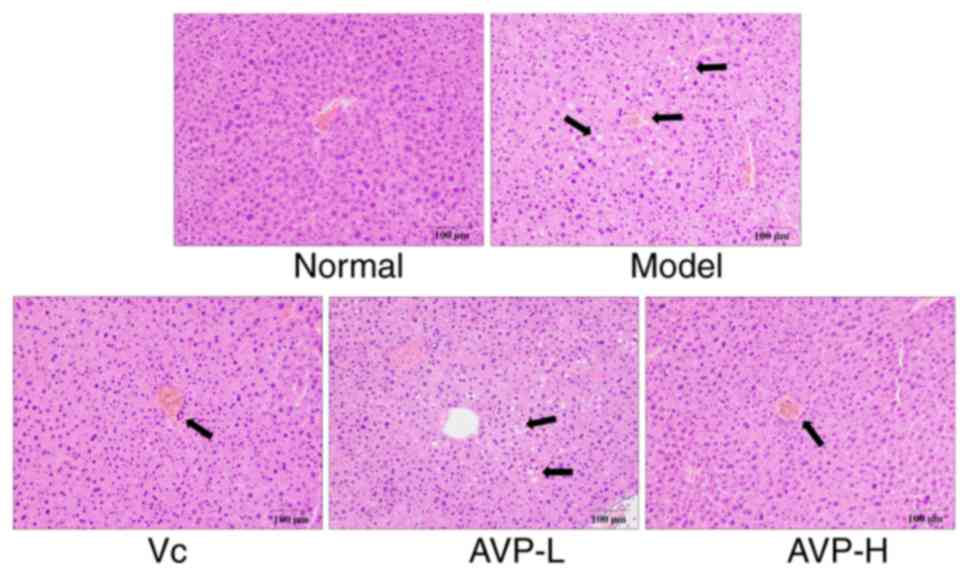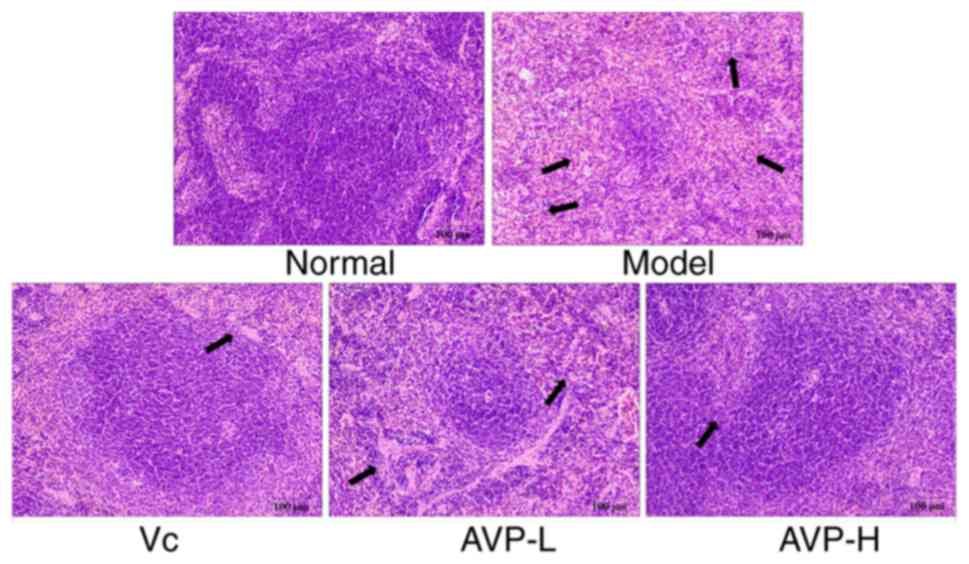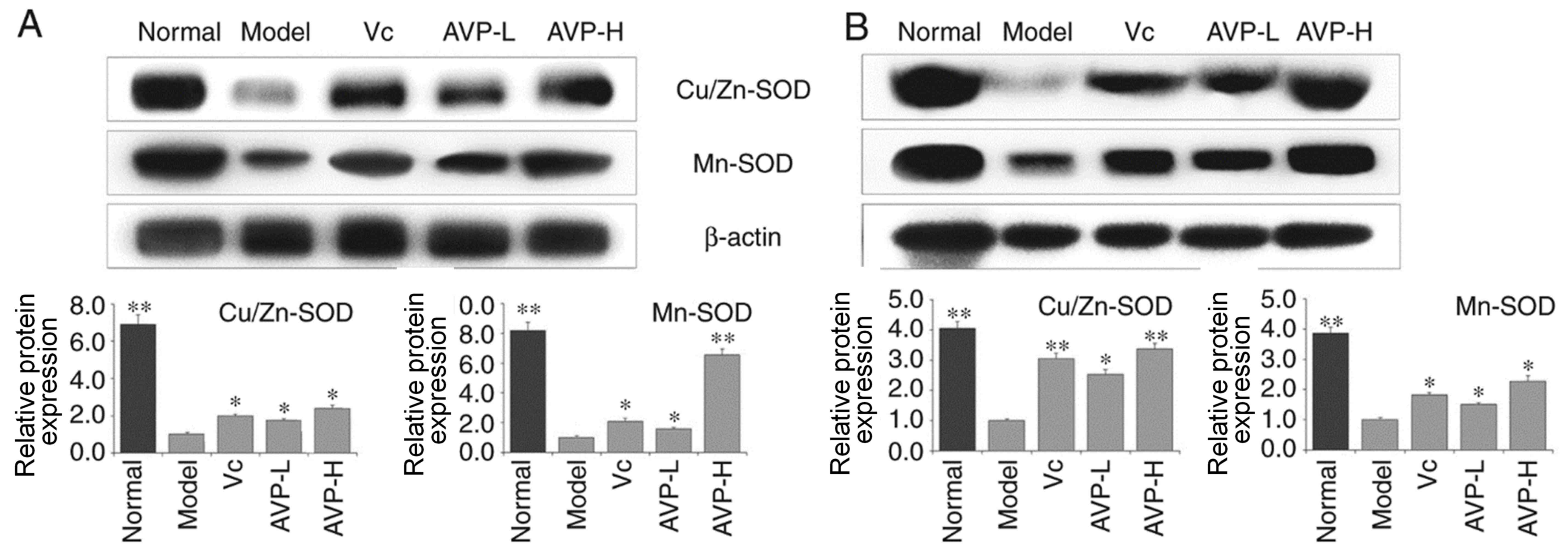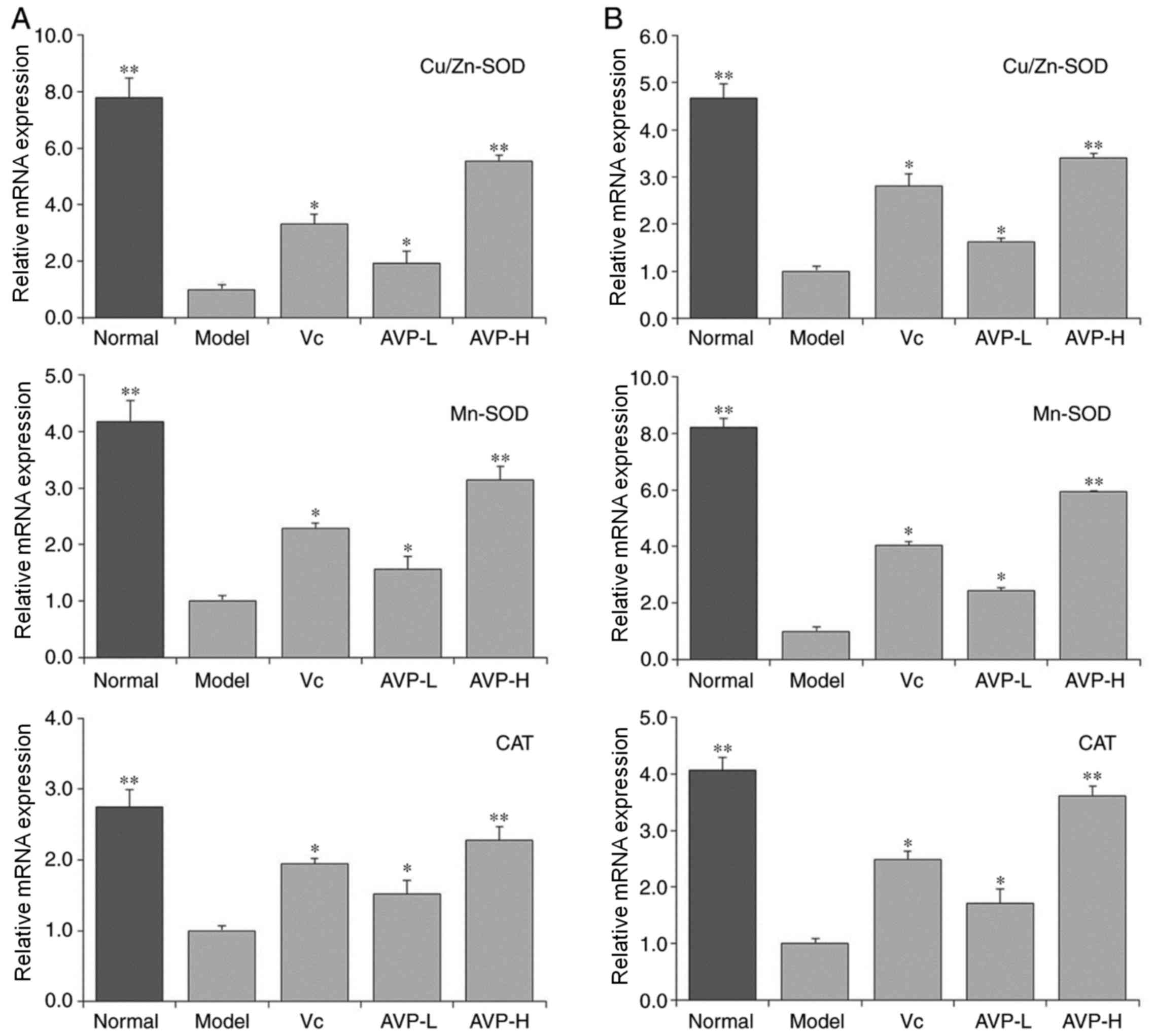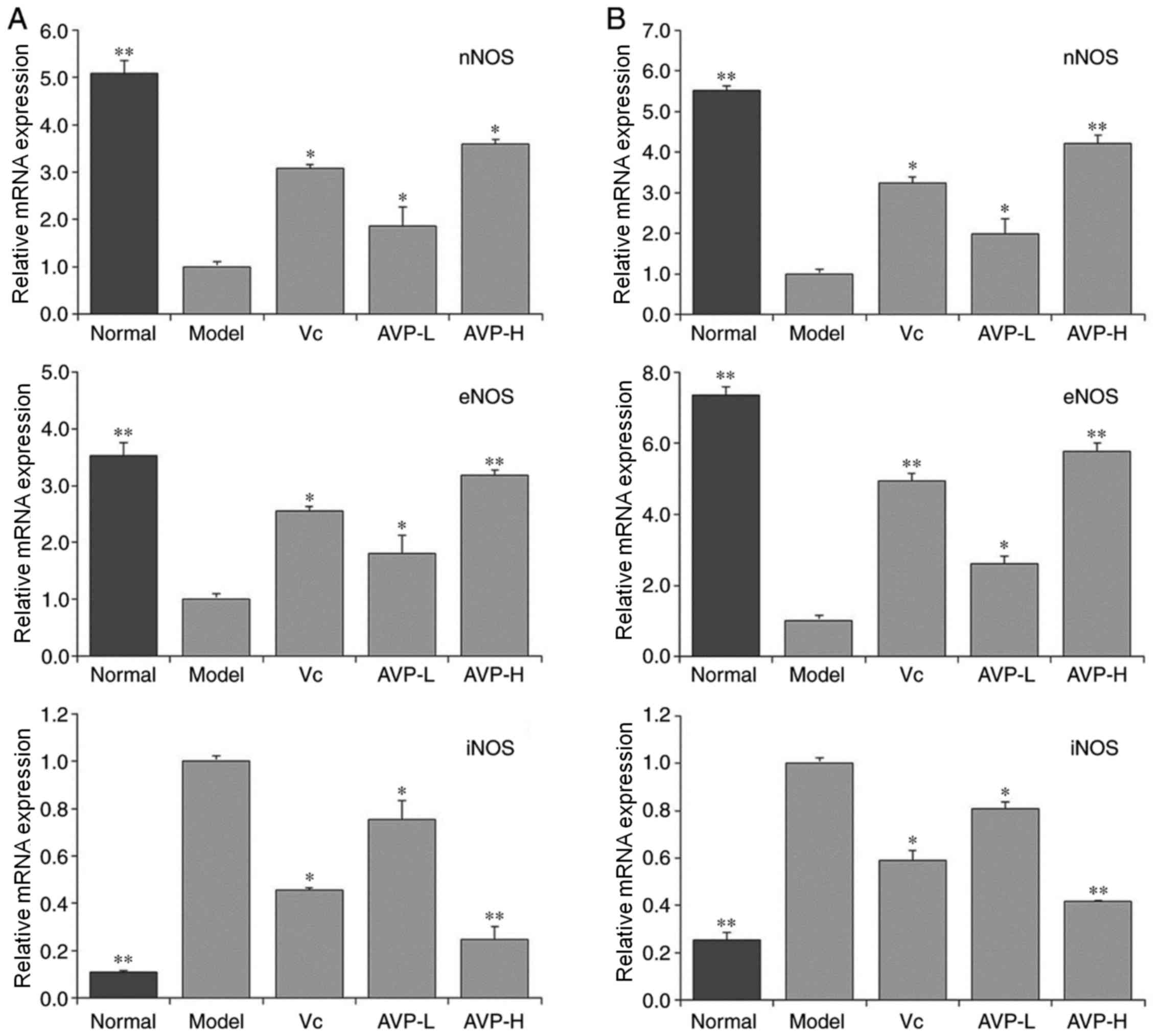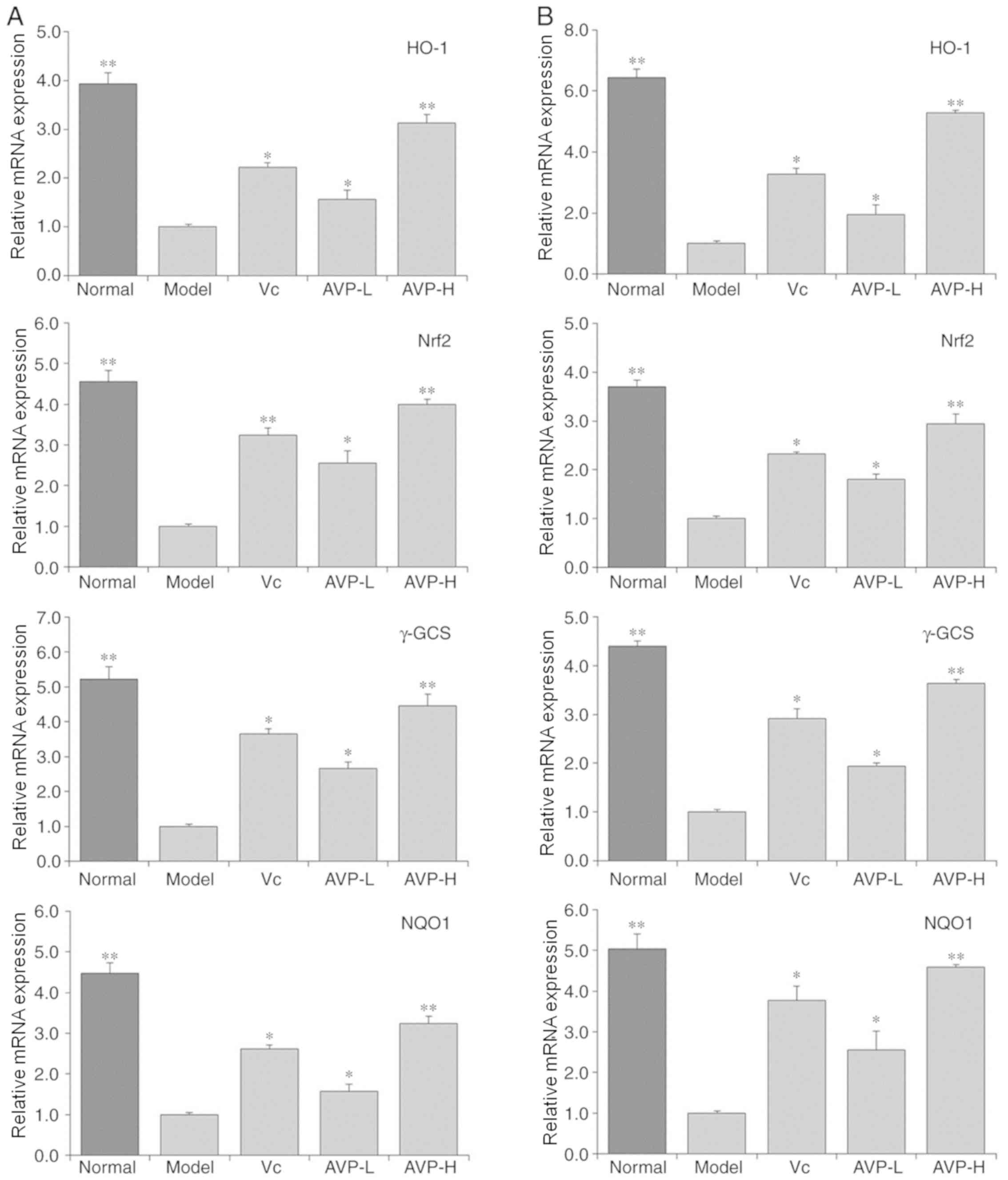|
1
|
Grundmann O, Nakajima J, Seo S and
Butterweck V: Anti-anxiety effects of Apocynum venetum L. in
the elevated plus maze test. J Ethnopharmacol. 110:406–411. 2007.
View Article : Google Scholar : PubMed/NCBI
|
|
2
|
Tan X and Peng Y: Research progress of
Apocynum venetum tea. Mod Chinese Med. 16:666–673. 2014.
|
|
3
|
Kim DW, Yokozawa T, Hattori M, Kadota S
and Namba T: Inhibitory effects of an aqueous extract of
Apocynum venetum leaves and its constituents on
Cu(2+)-induced oxidative modification of low density lipoprotein.
Phytother Res. 14:501–504. 2000. View Article : Google Scholar : PubMed/NCBI
|
|
4
|
Xiong Q, Fan W, Tezuka Y, Adnyana IK,
Stampoulis P, Hattori M, Namba T and Kadota S: Hepatoprotective
effect of Apocynum venetum and its active constituents.
Planta Med. 66:127–133. 2000. View Article : Google Scholar : PubMed/NCBI
|
|
5
|
Xie W, Zhang X, Wang T and Hu J: Botany,
traditional uses, phytochemistry and pharmacology of Apocynum
venetum L. (Luobuma): A review. J Ethnopharmacol. 141:1–8.
2012. View Article : Google Scholar : PubMed/NCBI
|
|
6
|
Buford TW: Hypertension and aging. Ageing
Res Rev. 26:96–111. 2016. View Article : Google Scholar : PubMed/NCBI
|
|
7
|
Chard S, Harris-Wallace B, Roth EG,
Girling LM, Rubinstein R, Reese AM, Quinn CC and Eckert JK:
Successful aging among african american older adults with type 2
diabetes. J Gerontol B Psychol Sci Soc Sci. 72:319–327.
2017.PubMed/NCBI
|
|
8
|
Kitada M, Ogura Y and Koya D: The
protective role of Sirt1 in vascular tissue: Its relationship to
vascular aging and atherosclerosis. Aging (Albany NY). 8:2290–2307.
2016. View Article : Google Scholar : PubMed/NCBI
|
|
9
|
Rao KS: Free radical induced oxidative
damage to DNA: Relation to brain aging and neurological disorders.
Indian J Biochem Biophys. 46:9–15. 2009.PubMed/NCBI
|
|
10
|
Hohensinner PJ, Kaun C, Ebenbauer B, Hackl
M, Demyanets S, Richter D, Prager M, Wojta J and Rega-Kaun G:
Reduction of premature aging markers after gastric bypass surgery
in morbidly obese patients. Obes Surg. 28:2804–2810. 2018.
View Article : Google Scholar : PubMed/NCBI
|
|
11
|
Li L, Xu M, Shen B, Li M, Gao Q and Wei
SG: Moderate exercise prevents neurodegeneration in
D-galactose-induced aging mice. Neural Regen Res. 11:807–815. 2016.
View Article : Google Scholar : PubMed/NCBI
|
|
12
|
Qian Y, Zhang J, Zhou X, Yi R, Mu J, Long
X, Pan Y, Zhao X and Liu W: Lactobacillus plantarum CQPC11 isolated
from Sichuan pickled cabbages antagonizes d-galactose-induced
oxidation and aging in mice. Molecules. 23(pii): E30262018.
View Article : Google Scholar : PubMed/NCBI
|
|
13
|
Li HY, Xia JQ, Yang LY and Zhong RZ: Plant
polyphenols: Antioxidant capacity and application in animal
production. China J Anim Nutr. 25:2529–2534. 2013.
|
|
14
|
Carluccio MA, Siculella L, Ancora MA,
Massaro M, Scoditti E, Storelli C, Visioli F, Distante A and De
Caterina R: Olive oil and red wine antioxidant polyphenols inhibit
endothelial activation: Antiatherogenic properties of Mediterranean
diet phytochemicals. Arterioscler Thromb Vasc Biol. 23:622–629.
2003. View Article : Google Scholar : PubMed/NCBI
|
|
15
|
Sharma S, Rana S, Patial V, Gupta M,
Bhushan S and Padwad YS: Antioxidant and hepatoprotective effect of
polyphenols from apple pomace extract via apoptosis inhibition and
Nrf2 activation in mice. Hum Exp Toxicol. 35:1264–1275. 2016.
View Article : Google Scholar : PubMed/NCBI
|
|
16
|
Delwing-Dal Magro D, Roecker R, Junges GM,
Rodrigues AF, Delwing-de Lima D, da Cruz JGP, Wyse ATS, Pitz HS and
Zeni ALB: Protective effect of green tea extract against
proline-induced oxidative damage in the rat kidney. Biomed
Pharmacother. 83:1422–1427. 2016. View Article : Google Scholar : PubMed/NCBI
|
|
17
|
Pan Y, Long X, Yi R and Zhao X:
Polyphenols in Liubao tea can prevent CCl4-induced
hepatic damage in mice through its antioxidant capacities.
Nutrients. 10:12802018. View Article : Google Scholar
|
|
18
|
Livak KJ and Schmittgen TD: Analysis of
relative gene expression data using real-time quantitative PCR and
the 2(-Delta Delta C(T)) method. Methods. 25:402–408. 2001.
View Article : Google Scholar : PubMed/NCBI
|
|
19
|
Li GJ, Wang J, Cheng YJ, Tan X, Zhai YL,
Wang Q, Gao FJ, Liu GL, Zhao X and Wang H: Prophylactic effects of
polymethoxyflavone-rich orange peel oil on
Nω-Nitro-L-arginine-induced hypertensive rats. Appl Sci.
8:7522018. View Article : Google Scholar
|
|
20
|
Tang T and He B: Treatment of D-galactose
induced mouse aging with Lycium barbarum polysaccharides and its
mechanism study. Afr J Tradit Complement Altern Med. 10:12–17.
2013.PubMed/NCBI
|
|
21
|
Khan SS, Singer BD and Vaughan DE:
Molecular and physiological manifestations and measurement of aging
in humans. Aging Cell. 16:624–633. 2017. View Article : Google Scholar : PubMed/NCBI
|
|
22
|
Manini TM: Energy expenditure and aging.
Ageing Res Rev. 9:12010. View Article : Google Scholar : PubMed/NCBI
|
|
23
|
Tessari P: Nitric oxide in the normal
kidney and in patients with diabetic nephropathy. J Nephrol.
28:257–268. 2015. View Article : Google Scholar : PubMed/NCBI
|
|
24
|
Wells SM and Holian A: Asymmetric
dimethylarginine induces oxidative and nitrosative stress in murine
lung epithelial cells. Am J Respir Cell Mol Biol. 36:520–528. 2007.
View Article : Google Scholar : PubMed/NCBI
|
|
25
|
Fukai T, Siegfried MR, Ushio-Fukai M,
Cheng Y, Kojda G and Harrison DG: Regulation of the vascular
extracellular superoxide dismutase by nitric oxide and exercise
training. J Clin Invest. 105:1631–1639. 2000. View Article : Google Scholar : PubMed/NCBI
|
|
26
|
Bonthius DJ Jr, Winters Z, Karacay B,
Bousquet SL and Bonthius DJ: Importance of genetics in fetal
alcohol effects: Null mutation of the nNOS gene worsens
alcohol-induced cerebellar neuronal losses and behavioral deficits.
Neurotoxicology. 46:60–72. 2015. View Article : Google Scholar : PubMed/NCBI
|
|
27
|
Lee MH, Hyun DH, Jenner P and Halliwell B:
Effect of proteasome inhibition on cellular oxidative damage,
antioxidant defences and nitric oxide production. J Neurochem.
78:32–41. 2001. View Article : Google Scholar : PubMed/NCBI
|
|
28
|
Kosenko EA, Tikhonova LA, Alilova GA,
Montoliu C, Barreto GE, Aliev G and Kaminsky YG: Portacaval
shunting causes differential mitochondrial superoxide production in
brain regions. Free Radic Biol Med. 113:109–118. 2017. View Article : Google Scholar : PubMed/NCBI
|
|
29
|
Selvaratnam JS and Robaire B: Effects of
aging and oxidative stress on spermatozoa of superoxide-dismutase
1- and catalase-null mice. Biol Reprod. 95:602016. View Article : Google Scholar : PubMed/NCBI
|
|
30
|
Pawlak W, Kedziora J, Zolynski K,
Kedziora-Kornatowska K, Blaszczyk J, Witkowski P and Zieleniewski
J: Effect of long term bed rest in men on enzymatic antioxidative
defence and lipid peroxidation in erythrocytes. J Gravit Physiol.
5:P163–P164. 1998.PubMed/NCBI
|
|
31
|
Berndt C and Lillig CH: Glutathione,
glutaredoxins, and iron. Antioxid Redox Signal. 27:1235–1251. 2017.
View Article : Google Scholar : PubMed/NCBI
|
|
32
|
Vázquez-Medina JP, Zenteno-Savín T, Forman
HJ, Crocker DE and Ortiz1 RM: Prolonged fasting increases
glutathione biosynthesis in postweaned northern elephant seals. J
Exp Biol. 214:1294–1299. 2011. View Article : Google Scholar : PubMed/NCBI
|
|
33
|
Hosen MB, Islam MR, Begum F, Kabir Y and
Howlader MZ: Oxidative stress induced sperm DNA damage, a possible
reason for male infertility. Iran J Reprod Med. 13:525–532.
2015.PubMed/NCBI
|
|
34
|
Sue YM, Cheng CF, Chang CC, Chou Y, Chen
CH and Juan SH: Antioxidation and anti-inflammation by haem
oxygenase-1 contribute to protection by tetramethylpyrazine against
gentamicin-induced apoptosis in murine renal tubular cells. Nephrol
Dial Transplant. 24:769–777. 2009. View Article : Google Scholar : PubMed/NCBI
|
|
35
|
Hong C, Cao J, Wu CF, Kadioglu O,
Schüffler A, Kauhl U, Klauck SM, Opatz T, Thines E, Paul NW and
Efferth T: The Chinese herbal formula Free and Easy Wanderer
ameliorates oxidative stress through KEAP1-NRF2/HO-1 pathway. Sci
Rep. 7:115512017. View Article : Google Scholar : PubMed/NCBI
|
|
36
|
Iwayama K, Kusakabe A, Ohtsu K, Nawano T,
Tatsunami R, Ohtaki KI, Tampo Y and Hayase N: Long-term treatment
of clarithromycin at a low concentration improves hydrogen
peroxide-induced oxidant/antioxidant imbalance in human small
airway epithelial cells by increasing Nrf2 mRNA expression. BMC
Pharmacol Toxicol. 18:152017. View Article : Google Scholar : PubMed/NCBI
|
|
37
|
Jiang XP, Tang JY, Xu Z, Han P, Qin ZQ,
Yang CD, Wang SQ, Tang M, Wang W, Qin C, et al: Sulforaphane
attenuates di-N-butylphthalate-induced reproductive damage in
pubertal mice: Involvement of the Nrf2-antioxidant system. Environ
Toxicol. 32:1908–1917. 2017. View Article : Google Scholar : PubMed/NCBI
|
|
38
|
Wang SX, Li AM, Zhang JJ, Ou SY, Huang XS
and Zhang GW: HPLC-ESI-MS analysis of phenolic compounds in
different solvent fractions of ethanol extract of longan seeds and
their antioxidant activities. Food Sci. 32:196–203. 2011.
|
|
39
|
Ramful D, Tarnus E, Aruoma OI, Bourdon E
and Bahorun T: Polyphenol composition, vitamin C content and
antioxidant capacity of Mauritian citrus fruit pulps. Food Res Int.
44:2088–2099. 2011. View Article : Google Scholar
|
|
40
|
Wittayarat M, Kimura T, Kodama R, Namula
Z, Chatdarong K, Techakumphu M, Sato Y, Taniguchi M and Otoi T:
Long-term preservation of chilled canine semen using vitamin C in
combination with green tea polyphenol. Cryo Lett. 33:318–326.
2012.
|
|
41
|
Bai JW, Gao ZJ, Xiao HW and Wang XT:
Polyphenol oxidase inactivation and vitamin C degradation kinetics
of Fuji apple quarters by high humidity air impingement blanching.
Int J Food Sci Technol. 48:1135–1141. 2013. View Article : Google Scholar
|
|
42
|
Yilixiati XKY and Li XJ: Inhibitory effect
of epigallocatechin gallate on the proliferation of lewis lung
cancer mice and A549 and Calu-3 lung cancer cells. Chin Pharm J.
47:585–589. 2012.
|
|
43
|
Shen SR, Jin CF, Yang XQ and Zhao BL:
Study on the scavenging effects of EGCG and GCG on singlet oxygen
with ESR method. J Tea Sci. 20:19–21. 2000.
|
|
44
|
Zhang LW, Ji T, Su SL, Shang RX, Guo S,
Guo JM, Qian DW and Duan JA: Pharmacokinetics of Mori Folium
flavones and alkaloids in normal and diabetic rats. Zhongguo Zhong
Yao Za Zhi. 42:4218–4225. 2017.(In Chinese). PubMed/NCBI
|
|
45
|
Hou N, Liu N, Han J, Yan Y and Li J:
Chlorogenic acid induces reactive oxygen species generation and
inhibits the viability of human colon cancer cells. Anticancer
Drugs. 28:59–65. 2017. View Article : Google Scholar : PubMed/NCBI
|
|
46
|
Yamagata K, Izawa Y, Onodera D and Tagami
M: Chlorogenic acid regulates apoptosis and stem cell
marker-related gene expression in A549 human lung cancer cells. Mol
Cell Biochem. 441:9–19. 2018. View Article : Google Scholar : PubMed/NCBI
|
|
47
|
Lukitasari M, Nugroho DA and Widodo N:
Chlorogenic acid: The conceivable chemosensitizer leading to cancer
growth suppression. J Evid Based Integr Med.
23:2515690X187896282018. View Article : Google Scholar : PubMed/NCBI
|
|
48
|
Li Q, Ren LQ, Wang YD and Chen XX: Effects
of rutin combined with oxaliplatin on the proliferation and
apoptosis of human gastric cancer SGC-7901 cells. Chin J Clin Pharm
Ther. 22:1099–1105. 2017.
|
|
49
|
Zhan P, Peng XS, Xu XM, Zhou YF, Zhang XP,
He R and Zhou G: The anti-cancer study on combinating paeonol and
rutin. Chin Arch Tradit Chin Med. 28:1710–1712. 2010.
|
|
50
|
Liu KY, Liu HJ, Wu JZ and Zhang TJ:
Studies on inhibitory effect of active constituents from Tussilago
farfara L. on lung cancer cells LA795 proliferation. J Fudan Univ
(Nat Sci). 48:125–129. 2009.
|
|
51
|
Li YY, Zhao SJ, Bai CZ, Zhang LW and Wang
ZH: Effect of isoquercetin from Fagopyrum tataricum on the
proliferation and apoptosis of human gastric carcinoma cell line
SGC-7901. Food Sci. 35:193–197. 2014.
|
|
52
|
Kim MS and Kim SH: Inhibitory effect of
astragalin on expression of lipopolysaccharide-induced inflammatory
mediators through NF-κB in macrophages. Arch Pharm Res.
34:2101–2107. 2011. View Article : Google Scholar : PubMed/NCBI
|
|
53
|
Tepe B, Eminagaoglu O, Akpulat HA and
Aydin E: Antioxidant potentials and rosmarinic acid levels of the
methanolic extracts of Salvia verticillata (L.) subsp.
Verticillataand S. verticillata (L.) subsp. Amasiaca (Freyn &
Bornm.) Bornm. Food Chem. 100:985–989. 2007. View Article : Google Scholar
|















